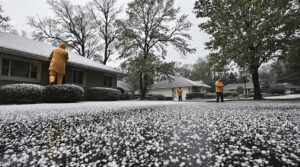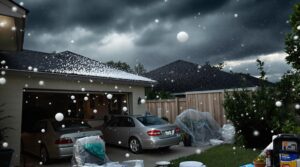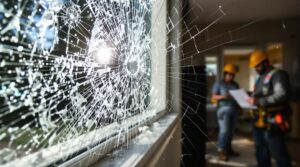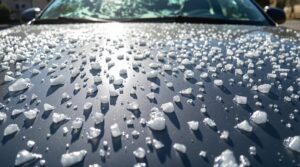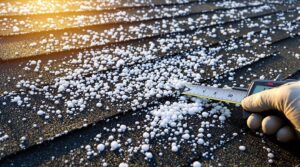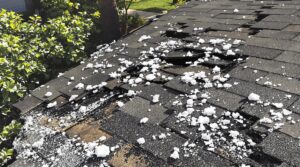Hail damage to window screens manifests as round tears, dents, and frame misalignment requiring prompt repair. DIY repairs involve using spline tools and replacement mesh, while professional services cost varies based on screen size and damage extent. Insurance coverage depends on policy terms, necessitating thorough documentation with photos and contractor estimates. Public adjusters can increase claim settlements by 300-400%. Strategic prevention methods and professional guidance offer extensive solutions for ideal damage resolution.
Key Takeaways
- Hail damage to window screens typically shows as round tears, dents, or holes in the mesh and frame misalignment.
- DIY screen repairs require basic tools like a spline tool and replacement mesh, costing $20-50 for materials.
- Professional window screen repairs average $50-200 per screen, depending on size and damage extent.
- Insurance often covers hail-damaged screens under homeowner policies when properly documented with photos and contractor estimates.
- Prevention methods include installing impact-resistant screens and storm protection, which can cost $100-300 per window.
Common Signs of Hail-Damaged Window Screens
Several distinct indicators reveal hail damage on window screens, requiring careful inspection of both the screen material and frame components.
The most common hail indicators include round tears or holes in the mesh, distinctive dents or dimples across the screen surface, and debris penetration that occurs without affecting the underlying glass.
Screen material types react differently to hail impact, with visible signs including streaking patterns and spatter marks from smaller hailstones.
Frame damage often accompanies screen deterioration, manifesting as dents, cracks, or misalignment that affects the screen's overall integrity.
Homeowners may notice sagging or displacement of the screen within its frame, particularly in cases of severe hail exposure.
Professional assessment typically reveals additional signs such as bent frame sections and compromised screen tension.
These damages can occur across various window materials, including vinyl, aluminum, and fiberglass, each displaying characteristic patterns of hail-related wear.
DIY Screen Repair Methods and Techniques
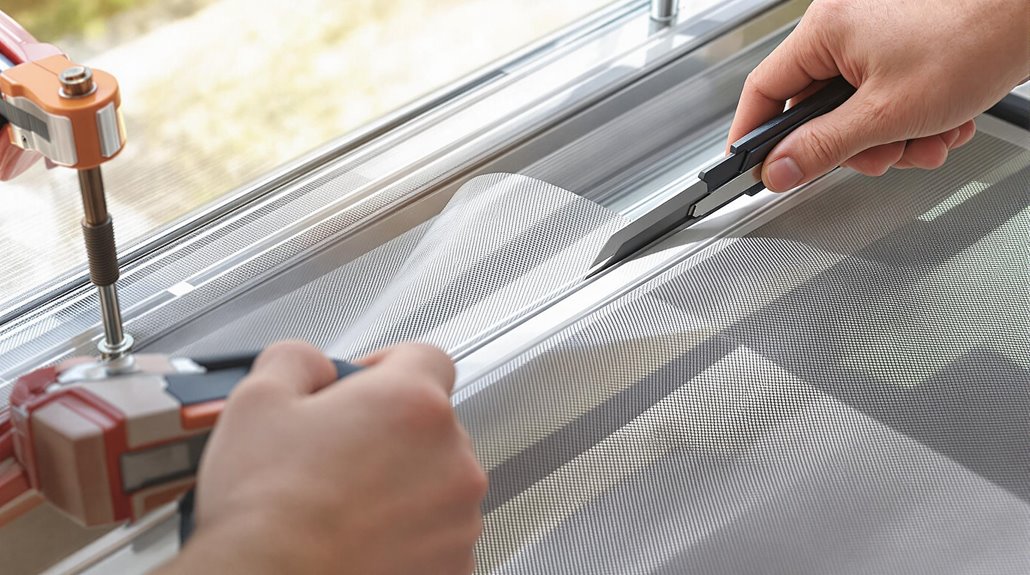
After identifying hail damage to window screens, homeowners can often perform repairs without professional assistance using readily available tools and materials. Both aluminum and fiberglass screen types are suitable for DIY repairs, with fiberglass being the more user-friendly option.
Essential repair tools include a spline tool, utility knife, and screen material matched to the original installation.
For successful screen repair, follow these critical steps:
- Remove damaged screen and spline using appropriate repair tools.
- Cut replacement screen material with adequate overlap.
- Install new screen using spline tool, working from corners.
- Trim excess material carefully with utility knife.
For minor hail damage, patch kits offer a quick solution without complete screen replacement.
When installing new screens, maintaining proper tension prevents rippling and guarantees longevity. Securing the frame with clamps during repair helps achieve professional-quality results, while careful spline installation prevents frame damage from over-tightening.
Professional Repair Services and Costs
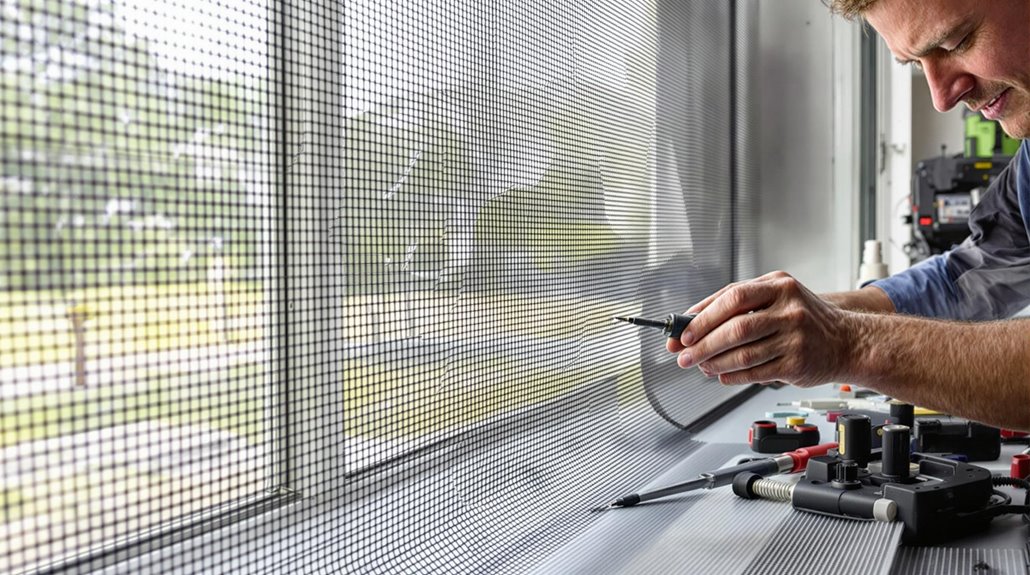
Professional screen repair services offer homeowners a reliable alternative to DIY repairs, providing expertise across diverse screen types and materials.
These services typically feature quick turnaround times and accommodate both residential and commercial clients through in-store or on-site repair options. Technicians specialize in handling various screen issues, ensuring durable and long-lasting repairs.
Cost estimation for screen repair varies based on multiple factors, including screen size, material type, and the extent of hail damage.
Service providers offer customized pricing and may include additional services such as screen cleaning and maintenance. Professional consultation helps determine accurate repair costs, particularly when custom screen manufacturing is required.
The convenience of professional services extends to specialized solutions, including custom-built screens to exact measurements.
These services prioritize customer satisfaction while utilizing high-quality materials and proven repair techniques, making them a practical choice for addressing hail-damaged screens.
Insurance Coverage and Documentation Requirements
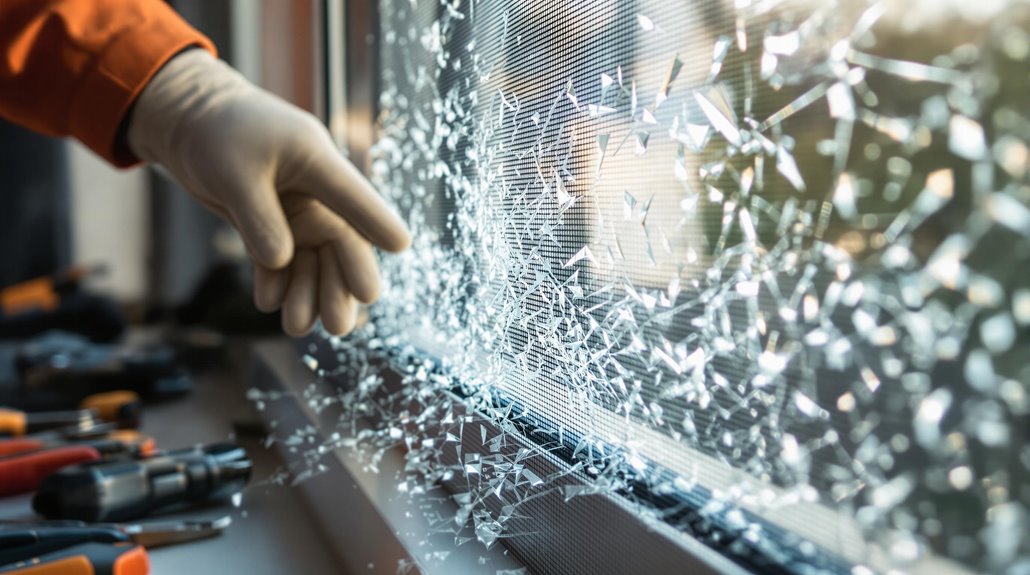
Insurance coverage for hail-damaged window screens varies among homeowners' policies, making thorough policy review a necessity before filing claims. Standard policies typically include coverage for storm-related damage, but deductibles and specific conditions apply. Proper documentation and claim timing are vital elements for successful reimbursement.
For ideal claim processing, policyholders must complete these essential steps:
- Document all damage thoroughly with detailed photos and videos, including close-up shots of affected screens.
- Obtain professional repair estimates from qualified contractors.
- Record all temporary repairs made to prevent further damage.
- Submit a completed claim form with supporting documentation to the insurance provider.
The insurance policy assessment process involves adjuster inspections and damage verification. Having extensive documentation ready during the inspection helps guarantee accurate damage assessment.
Policyholders should maintain detailed records of all communications with insurance representatives and track claim progress through resolution.
Public adjusters can provide expert assistance in negotiating complex storm damage claims with insurance companies.
Prevention Strategies and Storm Protection Options
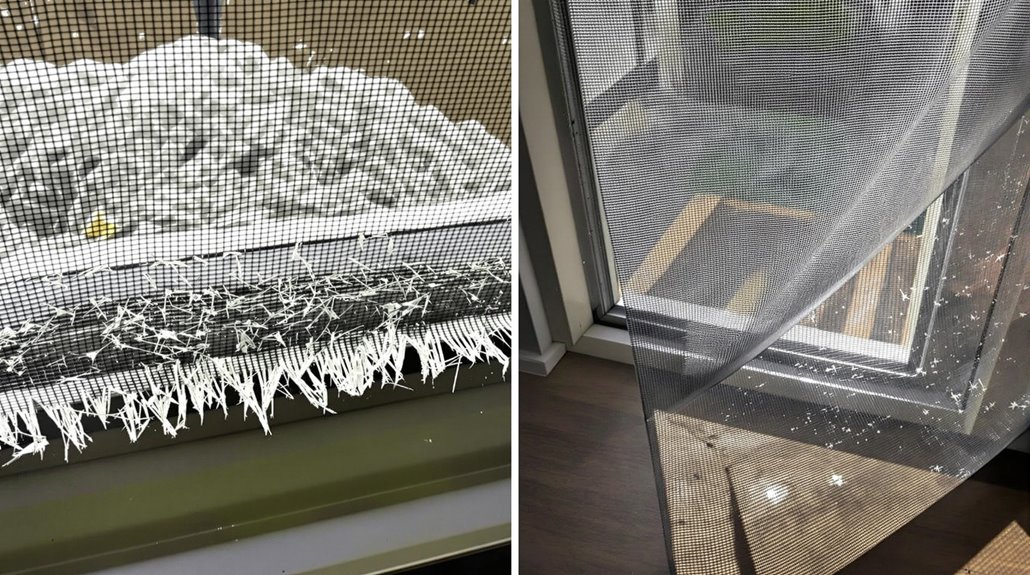
Effective storm protection for window screens requires a multi-layered approach combining structural reinforcement and strategic barrier systems. Impact-resistant windows paired with specialized storm screens provide thorough protection against hail damage, while window films offer additional durability and UV protection.
Storm preparedness involves installing hurricane window screens constructed from heavy-duty aluminum frames and stainless steel mesh, which can reduce hail damage risk by 40%. These screens feature secure locking mechanisms that comply with emergency egress requirements while maintaining visual appeal and functionality.
Regular window maintenance includes inspecting seals and frames for potential vulnerabilities. Anti-hail screens, made from high-density polyethylene, offer a cost-effective solution that's easily installed.
These transparent nets provide excellent protection while allowing light transmission. Combined with protective shutters, these systems create a robust defense against severe weather conditions. Property owners can maximize protection by implementing multiple preventive measures, notably reducing the likelihood of costly repairs.
The Benefits Of Consulting A Public Adjuster
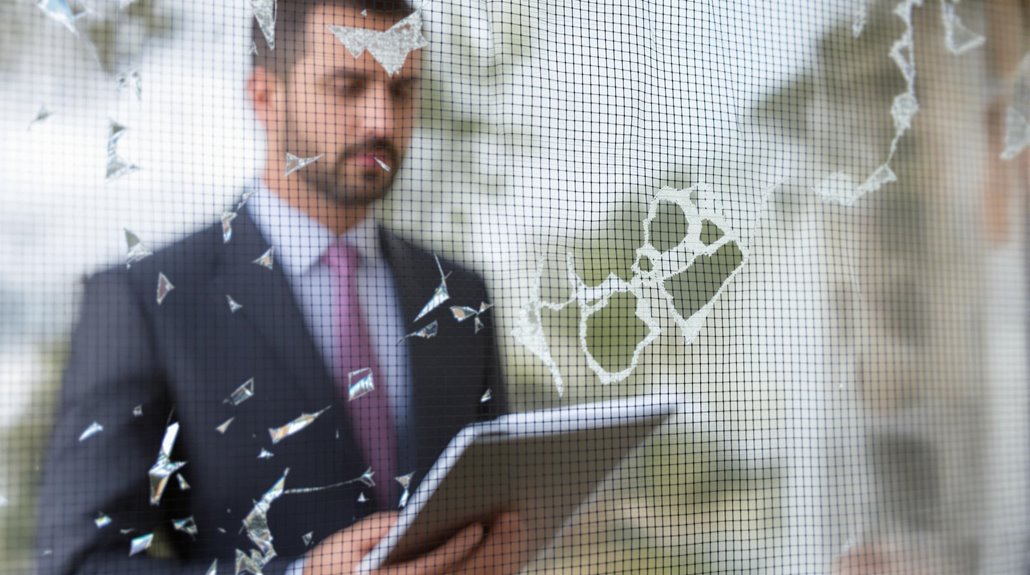
Consulting a public adjuster for hail-damaged window screens provides access to specialized expertise in insurance claims assessment and negotiation.
Public adjusters conduct objective damage evaluations that often identify issues overlooked in standard insurance inspections, while streamlining the claims process through professional documentation and efficient communication with insurance carriers.
Their involvement frequently results in higher claim settlements due to their thorough understanding of policy coverage, accurate damage valuation, and skilled representation of the policyholder's interests.
Studies show that claims handled by public adjusters result in 800% higher settlements compared to those without professional representation.
Expertise In Insurance Claims
When dealing with hail damage to window screens, enlisting the expertise of a public adjuster can greatly enhance the claims process and settlement outcome. Their thorough understanding of insurance policy interpretation and claims negotiation strategies guarantees maximum coverage for damaged screens and related property.
Public adjusters provide critical expertise through:
- Detailed analysis of policy coverage specific to hail damage and window screen repairs
- Professional documentation of damage extent and accurate cost assessments
- Strategic negotiation with insurance carriers to secure ideal settlements
- Expert guidance through complex claims procedures and requirements
These insurance professionals work on a contingency basis, typically charging up to 10% of the final settlement. Their specialized knowledge of insurance regulations and procedures helps policyholders navigate the claims process efficiently while maximizing their entitled benefits. Unlike claims management systems used by insurance company adjusters, public adjusters focus solely on protecting policyholder interests through personalized service and advocacy.
Objective Damage Assessment
A public adjuster's objective damage assessment provides property owners with an unbiased evaluation of hail-damaged window screens, eliminating potential conflicts of interest that may arise from insurance company assessments.
These professionals conduct thorough, unbiased inspections to identify both visible and concealed damage to window screens, frames, and surrounding components. Their specialized knowledge enables them to document subtle indications of hail impact that might otherwise go unnoticed.
Through technical expertise and experience, public adjusters compile extensive documentation that supports insurance claims effectively. Their objective evaluation extends beyond surface-level assessment, incorporating detailed analysis of policy coverage and potential long-term implications of hail damage.
This systematic approach guarantees that property owners receive fair compensation for all legitimate damage, backed by professional documentation and expert interpretation of insurance terms.
Working on a contingency-based fee structure in most states, public adjusters are motivated to secure the maximum possible settlement for property owners.
Streamlined Claim Process
Public adjusters streamline the insurance claims process by providing thorough management of hail-damaged window screen cases from initial documentation through final settlement.
Their expertise in policy navigation guarantees proper interpretation of coverage terms while maintaining claim efficiency throughout the process.
Key advantages of utilizing a public adjuster for hail-damaged window screens include:
- Professional documentation and assessment of all damaged screens, guaranteeing accurate representation
- Expert interpretation of policy language specific to exterior damage coverage
- Management of all communications and negotiations with insurance carriers
- Strategic guidance through technical requirements and time constraints
This professional representation protects homeowners' interests while expediting the claims process, allowing property owners to focus on recovery rather than administrative complexities.
Public adjusters' specialized knowledge helps secure fair settlements while minimizing potential claim denials or underpayments.
Studies show property damage settlements increase by 30-50% when working with a public adjuster.
Higher Claim Payouts & Settlements
Statistics consistently show that property owners who engage public adjusters for hail-damaged window screen claims secure considerably higher settlements compared to those who handle claims independently.
This success stems from public adjusters' expertise in claim strategies and detailed damage assessments that identify often-overlooked issues.
These professionals employ sophisticated negotiation tactics when dealing with insurance companies, leveraging their thorough understanding of policy terms and industry practices.
Their specialized knowledge enables them to counter common insurance company strategies aimed at minimizing payouts.
Working on a commission basis, public adjusters are inherently motivated to maximize settlement amounts while handling all documentation and negotiations.
This arrangement allows property owners to benefit from professional expertise while avoiding the stress and time investment of managing complex claims procedures independently.
About The Public Claims Adjusters Network (PCAN)
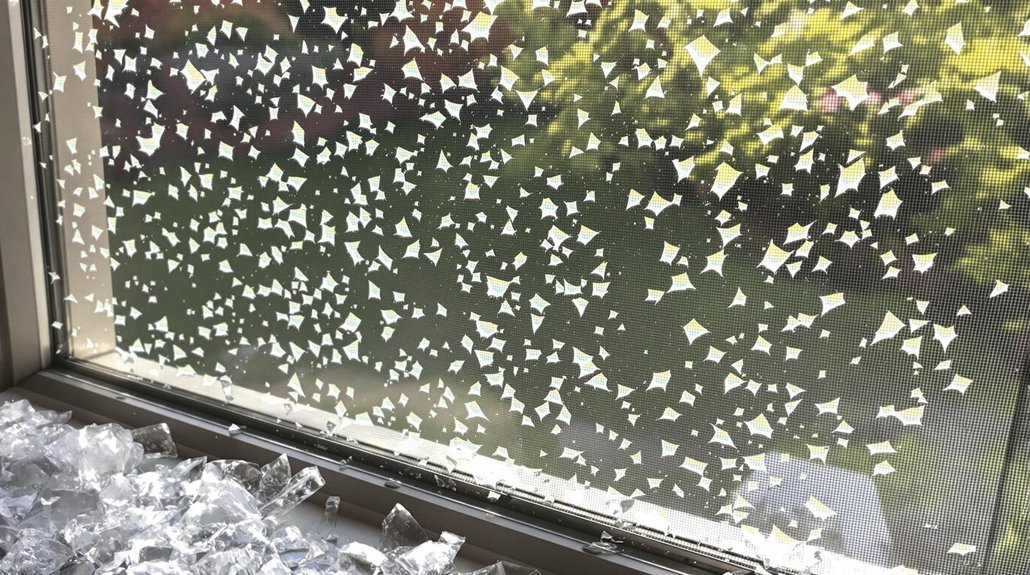
Professional insurance advocacy takes shape through The Public Claims Adjusters Network (PCAN), an organization of licensed and bonded experts who work exclusively for policyholders during insurance claims. Their extensive claim handling process encompasses thorough damage assessments, detailed documentation, and expert negotiation with insurance companies to maximize settlements.
Public Adjuster Roles within PCAN focus on delivering measurable results through these core services:
- Extensive property damage inspections with detailed loss documentation
- Professional claim preparation and submission to insurance carriers
- Strategic negotiation to secure ideal settlement values
- Round-the-clock support throughout the entire claims process
PCAN members typically operate on a contingency fee basis, charging no upfront costs and collecting payment only after successful claim resolution. Their expertise consistently yields settlement increases of 300-400% compared to unrepresented claims, while saving policyholders valuable time through professional claim management and insurance company negotiations.
Frequently Asked Questions
How Long Does Hail Damage Typically Take to Cause Screen Deterioration Over Time?
Screen deterioration timeline varies from immediate damage to progressive decline over 3-12 months, depending on hail impact factors including stone size, environmental conditions, and existing screen integrity.
Can Window Screens Be Reinforced After Hail Damage to Prevent Future Tears?
Window screens can undergo effective screen reinforcement through heavy-duty materials, protective films, and frame fortification. These modifications enhance structural integrity and provide sustainable damage prevention against future impacts.
What Weather Conditions Increase the Likelihood of Hail Damaging Window Screens?
Severe thunderstorms with intense updrafts increase hail frequency, while high wind speeds amplify impact force. Regional weather patterns, seasonal changes, and proximity to storm centers elevate damage potential.
Do Certain Window Screen Materials Show Hail Damage More Visibly Than Others?
Like leaves revealing their distinct autumn colors, aluminum and copper screen materials display hail damage most visibly, while stainless steel and fiberglass screens typically show less visual impact from strikes.
How Often Should Window Screens Be Inspected for Delayed Signs of Hail Damage?
Monthly inspection frequency is recommended for monitoring delayed damage indicators, with additional checks after weather events and thorough seasonal evaluations to identify developing structural and material issues.
References
- https://vikingcontractorsllc.com/the-most-common-signs-of-hail-damaged-windows/
- https://www.southwestexteriors.com/blog/the-best-solutions-for-hail-damaged-windows
- https://dokumen.pub/simon-and-schuster-handbook-for-writers-11nbsped-9780134172828-0134172825-013470133x-9780134701332-013471380x-9780134713809.html
- https://brennancorp.com/blog/everything-you-need-to-know-about-hail-damage-to-windows/
- https://www.pjfitz.com/diy/window-repair/how-to-patch-a-window-screen/
- https://bestexteriorsinc.com/blog/hail-damage-to-windows/
- https://www.fourseasonskc.com/blog/p.230209003/3-signs-your-windows-are-damaged-from-spring-storms/
- https://www.pellaomaha.com/blog/hail-damage-to-window-trim-what-every-homeowner-needs-to-know/
- https://www.nachi.org/hail-damage-part10-37.htm
- https://www.youtube.com/watch?v=t7emMleueHg

